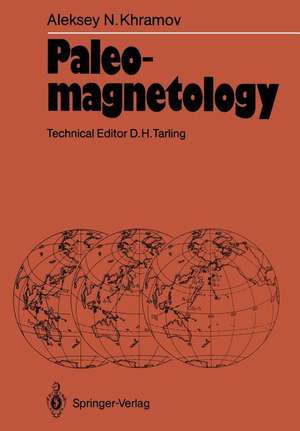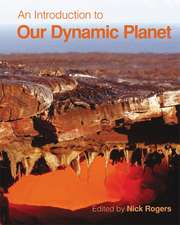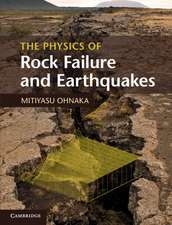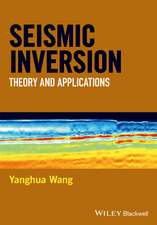Paleomagnetology
Autor Aleksey N. Khramov Traducere de Valentina P. Grudina D.H. Tarlingen Limba Engleză Paperback – 16 noi 2011
Preț: 644.49 lei
Preț vechi: 758.23 lei
-15% Nou
Puncte Express: 967
Preț estimativ în valută:
123.32€ • 129.10$ • 102.04£
123.32€ • 129.10$ • 102.04£
Carte tipărită la comandă
Livrare economică 05-19 aprilie
Preluare comenzi: 021 569.72.76
Specificații
ISBN-13: 9783642717529
ISBN-10: 3642717527
Pagini: 332
Ilustrații: XIX, 308 p.
Dimensiuni: 170 x 244 x 17 mm
Greutate: 0.53 kg
Ediția:Softcover reprint of the original 1st ed. 1987
Editura: Springer Berlin, Heidelberg
Colecția Springer
Locul publicării:Berlin, Heidelberg, Germany
ISBN-10: 3642717527
Pagini: 332
Ilustrații: XIX, 308 p.
Dimensiuni: 170 x 244 x 17 mm
Greutate: 0.53 kg
Ediția:Softcover reprint of the original 1st ed. 1987
Editura: Springer Berlin, Heidelberg
Colecția Springer
Locul publicării:Berlin, Heidelberg, Germany
Public țintă
ResearchCuprins
1 Physical and Geophysical Aspects of Paleomagnetology.- 1.1 Magnetic Values and Magnetic Units.- 1.2 Principal Properties of the Geomagnetic Field.- 1.2.1 Elements of the Earth’s Magnetism.- 1.2.2 Origin of the Geomagnetic Field.- 1.2.3 Principle of the Central Axial Dipole and the Paleomagnetic Field.- 1.2.4 Models of the Geomagnetic Field.- 1.3 General Data on Rock Magnetism.- 1.3.1 Principal Magnetic Properties of Materials.- 1.3.2 Magnetic Properties of Rocks.- 1.3.3 Assemblage of Single-Domain, Noninteracting Particles.- 1.3.4 Magnetic Viscosity.- 1.4 Types of Remanent Magnetization of Rocks.- 1.4.1 Remanent, Induced and Viscous Magnetizations.- 1.4.2 Thermoremanent Magnetization.- 1.4.3 Detrital Remanent Magnetization.- 1.4.4 Chemical Remanent Magnetization.- 1.4.5 Pressure Effects Upon Remanent Magnetization.- 1.4.6 Isothermal and Anhysteretic Remanent Magnetizations.- 1.4.7 Stability of Remanent Magnetization.- 1.4.8 Spectra of Demagnetization and the Principles of Magnetic Cleaning.- 1.5 Ferromagnetic Properties of Rocks.- 1.5.1 Mineral-Carriers of the Ferromagnetic Properties of Rocks.- 1.5.2 Certain Magnetic Characteristics of Rocks.- 1.5.3 Natural Remanent Magnetization Jn of Rocks.- 1.5.4 Physical and Chronologic Components of the NRM; Paleomagnetic Stability of Rocks.- 1.5.5 Problem of Acquisition of Reversed Magnetization in a Rock.- 1.6 Distribution of Directions of Natural Remanent Magnetization in Rocks.- 1.6.1 Initial Paleomagnetic Data and the Drawing of Magnetic Directions.- 1.6.2 Fisher’s Distribution.- 1.6.3 Observed Distributions of Magnetization Jn in Rocks.- 2 Methods and Techniques Used in Paleomagnetic Studies.- 2.1 Principles of the Investigation of Geologic Bodies; Collection of Oriented Samples.- 2.1.1 Objects of Paleomagnetic Studies.- 2.1.2 Techniques Used in the Study of Geological Bodies.- 2.1.3 Orientation of Samples and Specimen Preparation.- 2.2 Magnetic Measurements.- 2.2.1 Equipment Used in Magnetic Measurements.- 2.2.2 Astatic Magnetometers.- 2.2.3 Spinner Magnetometer.- 2.2.4 Fluxgate Magnetometer.- 2.3 Field Methods Used in the Determination of Ancient Magnetization.- 2.3.1 Evaluation of the Paleomagnetic Stability of Rocks.- 2.3.2 Determination of the Degree of Paleomagnetic Stability.- 2.3.3 Determination of the Direction of Ancient Magnetization.- 2.3.4 Field Methods Used in the Estimation of the Synchroneity of Ancient Magnetization.- 2.4 Magnetic Stability Tests and Magnetic Cleaning.- 2.4.1 General.- 2.4.2 Temporal Cleaning and the Compensation Method.- 2.4.3 Alternating Magnetic Field Cleaning.- 2.4.4 Thermal Cleaning.- 2.4.5 Chemical Cleaning.- 2.4.6 Low-Temperature Cleaning.- 2.4.7 Combined Cleanings.- 2.4.8 Methods for the Presentation of Magnetic Cleaning Data and Their Interpretation.- 2.5 Analysis of the Origin of Ancient Magnetizations.- 2.6 Statistical Analysis of the Paleomagnetic Directions and Poles.- 2.6.1 The Best Estimates of Mean Direction and Precision Parameters.- 2.6.2 Estimates of the Accuracy of the Determination for Unit and Mean Directions of NRM.- 2.6.3 Choice of the Set of the NRM Directions.- 2.6.4 Fit of the Observed NRM to Fisher’s Distribution.- 2.6.5 Two-Tier Statistical Analysis.- 2.6.6 Virtual Geomagnetic and Paleomagnetic Pole Distributions and Their Confidence Ovals.- 2.7 Methods Used in the Determination of the Geomagnetic Field Intensity in the Geological Past.- 2.7.1 The Basic Principles of the Ancient Geomagnetic.- Field Intensity Determination.- 2.7.2 Estimation of the Ancient Field Ha by the Redeposition Method.- 2.7.3 Method of Magnetic Anisotropic Parameters.- 2.7.4 Thellier’s Method.- 2.7.5 Method of Anhysteretic Magnetization.- 2.7.6 Method of Stepwise Remagnetization.- 2.7.7 Estimation of the Ancient Field Intensity Ha by Q0 the Factor.- 3 The Geomagnetic Field in the Phanerozoic and the Magnetostratigraphic Scale.- 3.1 Geomagnetic Reversals and Geomagnetic Polarity Scales.- 3.1.1 Evidence of Geomagnetic Reversals.- 3.1.2 Types of Geomagnetic Polarity Scales.- 3.1.3 Dating of Polarity Epochs on Lava Flows; the Magnetochronologic Scale.- 3.1.4 Zones of Geomagnetic Polarity in Bottom Sediments of the World Ocean.- 3.1.5 Scale of Marine Magnetic Anomalies.- 3.1.6 Construction of a Magnetostratigraphic Polarity Scale: Principles and Problems.- 3.2 The Phanerozoic Magnetostratigraphic Scale.- 3.2.1 Structure of the Magnetostratigraphic Scale for the USSR.- 3.2.2 Paleozoic.- 3.2.3 Mesozoic.- 3.2.4 Cenozoic.- 3.2.5 Correlation of the Phanerozoic Paleomagnetic Scale for the USSR and the World Paleomagnetic Data.- 3.3.6 Comparison of the Mesozoic Paleomagnetic Scale of the USSR and the Scale of Marine Magnetic Anomalies.- 3.3 Mechanisms of Geomagnetic Reversals and Their Morphology.- 3.3.1 Possible Mechanisms of Geomagnetic Reversals.- 3.3.2 Morphology of Geomagnetic Reversals.- 3.3.3 Morphology of the Early Paleozoic Reversals.- 3.3.4 Reversals at the Paleozoic-Mesozoic Boundary.- 3.3.5 Reversals in the Late Mesozoic-Cenozoic.- 3.3.6 Morphology of Geomagnetic Reversals: Conclusions.- 3.4 Time Structure of the Geomagnetic Field Between the Reversals.- 3.4.1 Events and Excursion of the Geomagnetic Field.- 3.4.2 Paleosecular Variations of the Geomagnetic Field.- 3.5 Regularities in the Spatial Distribution of the Paleomagnetic Field.- 3.5.1 Paleomagnetic Field; Procedures of Isolation and Analysis.- 3.5.2 Paleomagnetic Field During the Carboniferous and Permian and the Model of the Central Axial Dipole.- 3.5.3 Asymmetric (Anomalous) and Axially Symmetric Nondipole Fields.- 3.5.4 Model of Noncentral Axial Dipole and Its Testing.- 3.5.5 Spherical Harmonic Analysis of Paleomagnetic Data.- 3.6 The Intensity of the Geomagnetic Field in the Phanerozoic.- 4 Paleomagnetism and Plate Tectonics.- 4.1 Paleomagnetic Studies of Plate Movements and Fold Belt Tectonics.- 4.1.1 Application of Paleomagnetic Methods inTectonics.- 4.1.2 Principles of Paleomagnetic Methods in Solving Tectonic Tasks.- 4.1.3 Principles of Analysis and Selection of Paleomagnetic Data.- 4.2 Apparent Polar Wander Path for Major Plates; Formation and Break-Up of Supercontinents.- 4.2.1 Paleomagnetic Poles and Their Wandering.- 4.2.2 Apparent Polar Wander Paths for Major Plates.- 4.2.3 Reconstruction of the Relative Positions of Two Continents.- 4.2.4 Formation and Break-Up of Supercontinents.- 4.3 Paleomagnetic Poles and Movements of the Russian and Siberian Platforms in the Paleozoic.- 4.3.1 Apparent Polar Wander Paths of the Russian and Siberian Platforms.- 4.3.2 Paleozoic Drift of the Siberian and Russian Platforms.- 4.4 Paleomagnetic Poles and Plate Kinematics.- 4.4.1 Reconstruction of Plate Positions.- 4.4.2 Determination of Kinematic Parameters of Plate Movement.- 4.4.3 Paleomagnetism of Seamounts and Movement of Oceanic Plates.- 4.5 Global Reconstructions for the Paleozoic and Mesozoic Epochs.- 4.5.1 Global Reconstructions for the Mesozoic and Paleogene.- 4.5.2 Global Reconstructions for the Middle and Late Paleozoic.- 4.5.3 Examples of Global Reconstructions for the Late Proterozoic and Early Paleozoic.- 4.5.4 History of Horizontal Motions of the Major Lithospheric Plates in the Proterozoic and Phanerozoic: Conclusions.- 5 Paleomagnetism and Tectogenetie Problems.- 5.1 Paleomagnetism in Fold Belts.- 5.1.1 Components of Tectonic Movements and Their Paleomagnetic Studies.- 5.1.2 The Determination of Local Movements and Correction for Their Effects; General Solution.- 5.1.3 The Determination of Local Movements and Correction for Their Effects; A Special Case.- 5.1.4 Regional and Local Components of Tectonic Movements.- 5.2 Palinspastic Reconstructions According to Paleomagnetic Data.- 5.2.1 Local Tectonic Movements in the Tajik Depression and in Southern Tien Shan.- 5.2.2 Construction of the Palinspastic Scheme of the Tajik Depression in the Early Cretaceous.- 5.2.3 Reconstruction of the Paleogene Sedimentary Basin of the Tajik Depression.- 5.2.4 Palinspastic Scheme for Central Asia During the Early Permian Epoch.- 5.3 Deformations in Certain Fold Belts of Eurasia According to Paleomagnetic Data.- 5.3.1 On the Nature of Tectonic Deformations in the Alpine-Himalayan Fold Belt.- 5.3.2 Deformations in the Urals Belt.- 5.3.3 Deformations in the Areas Surrounding the Siberian Platform.- 5.4 Tectogenesis and Rhythmicity of Geomagnetic Reversals.- 5.5 A General Hypothesis of Tectogenesis.- 5.5.1 Hypothesis of Planetary Equilibrium.- 5.5.2 Drift of the Lithospheric Plates and the Coriolis Force.- 6 Paleomagnetology and Mineral Deposits.- 6.1 Introductory Remarks.- 6.2. Paleolatitudinal Constraint on Crustal Deformation.- 6.3. Types of Oil and Gas Basins, Their Genesis and Distribution.- 6.4 Paleolatitudinal Distribution of Mineral Deposits.- 6.4.1 Coal.- 6.4.2 Salt.- 6.4.3 Oil and Gas.- 6.4.4 Ore Deposits.- 6.5 Association of Transgressions with Certain Paleolatitudes.- 6.6 Paleomagnetic-Tectonic Criteria in Outlining Oil and Gas Fields.- 7 Certain Problems of Paleomagnetism.- 7.1 Synchronous and Metachronous Components of the Ancient Magnetization: The Problem of Late Paleozoic Remagnetization.- 7.2 Hypothesis of the Earth’s Expansion.- 7.3 Paleomagnetism of the Precambrian.- References.










